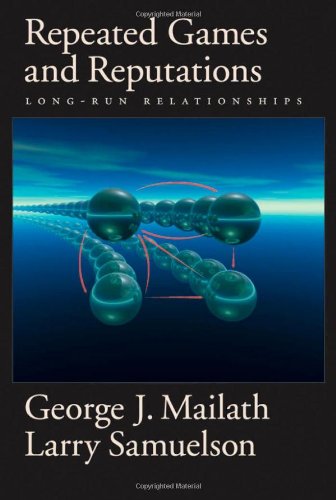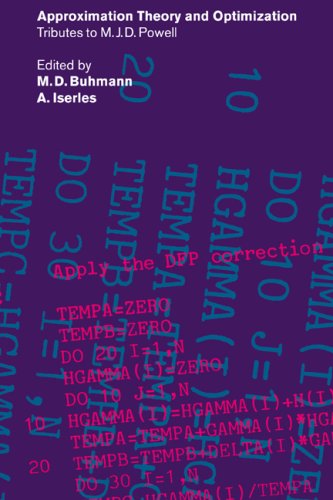George J. Mailath, Larry Samuelson9780195300796, 0-19-530079-3
Table of contents :
Contents……Page 10
1.1 Intertemporal Incentives……Page 20
1.2 The Prisoners’ Dilemma……Page 22
1.3 Oligopoly……Page 23
1.4 The Prisoner’s Dilemma under Imperfect Monitoring……Page 24
1.5 The Product-Choice Game……Page 26
1.6 Discussion……Page 27
1.8 The Scope of the Book……Page 29
Part I: Games with Perfect Monitoring……Page 32
2.1 The Canonical Repeated Game……Page 34
2.2 The One-Shot Deviation Principle……Page 43
2.3 Automaton Representations of Strategy Profiles……Page 48
2.4 Credible Continuation Promises……Page 51
2.5 Generating Equilibria……Page 56
2.6 Constructing Equilibria: Simple Strategies and Penal Codes……Page 70
2.7 Long-Lived and Short-Lived Players……Page 80
3 The Folk Theorem with Perfect Monitoring……Page 88
3.1 Examples……Page 89
3.2 Interpreting the Folk Theorem……Page 91
3.3 The Pure-Action Folk Theorem for Two Players……Page 95
3.4 The Folk Theorem with More than Two Players……Page 99
3.5 Non-Equivalent Utilities……Page 106
3.6 Long-Lived and Short-Lived Players……Page 110
3.7 Convexifying the Equilibrium Payoff Set Without Public Correlation……Page 115
3.8 Mixed-Action Individual Rationality……Page 120
4.1 Is the Horizon Ever Infinite?……Page 124
4.2 Uncertain Horizons……Page 125
4.3 Declining Discount Factors……Page 126
4.4 Finitely Repeated Games……Page 131
4.5 Approximate Equilibria……Page 137
4.6 Renegotiation……Page 139
5.1 Random Matching……Page 164
5.2 Relationships in Context……Page 171
5.3 Multimarket Interactions……Page 180
5.4 Repeated Extensive Forms……Page 181
5.5 Dynamic Games: Introduction……Page 193
5.6 Dynamic Games: Foundations……Page 205
5.7 Dynamic Games: Equilibrium……Page 211
6.1 Price Wars……Page 220
6.2 Time Consistency……Page 223
6.3 Risk Sharing……Page 227
Part II: Games with (Imperfect) Public Monitoring……Page 242
7.1 The Canonical Repeated Game……Page 244
7.2 A Repeated Prisoners’ Dilemma Example……Page 251
7.3 Decomposability and Self-Generation……Page 260
7.4 The Impact of Increased Precision……Page 268
7.5 The Bang-Bang Result……Page 270
7.6 An Example with Short-Lived Players……Page 274
7.7 The Repeated Prisoners’ Dilemma Redux……Page 283
7.8 Anonymous Players……Page 288
8.1 Decomposing on Half-Spaces……Page 292
8.2 The Inefficiency of Strongly Symmetric Equilibria……Page 297
8.3 Short-Lived Players……Page 299
8.4 The Prisoners’ Dilemma……Page 301
9.1 Characterizing the Limit Set of PPE Payoffs……Page 312
9.2 The Rank Conditions and a Public Monitoring Folk Theorem……Page 317
9.3 Perfect Monitoring Characterizations……Page 322
9.4 Enforceability and Identifiability……Page 324
9.5 Games with a Product Structure……Page 328
9.6 Repeated Extensive-Form Games……Page 330
9.7 Games of Symmetric Incomplete Information……Page 335
9.8 Short Period Length……Page 345
10.1 Sequential Equilibrium……Page 348
10.2 A Reduced-Form Example……Page 350
10.3 Two-Period Examples……Page 353
10.4 An Infinitely Repeated Prisoner’s Dilemma……Page 359
11.1 Oligopoly with Imperfect Monitoring……Page 366
11.2 Repeated Adverse Selection……Page 373
11.3 Risk Sharing……Page 384
11.4 Principal-Agent Problems……Page 389
Part III: Games with Private Monitoring……Page 402
12.1 A Two-Period Example……Page 404
12.2 Private Monitoring Games: Basic Structure……Page 413
12.3 Almost Public Monitoring: Robustness in the Infinitely Repeated Prisoner’s Dilemma……Page 416
12.4 Independent Monitoring: A Belief-Based Equilibrium for the Infinitely Repeated Prisoner’s Dilemma……Page 423
12.5 A Belief-Free Example……Page 429
13.1 When Is Monitoring Almost Public?……Page 434
13.2 Nearby Games with Almost Public Monitoring……Page 437
13.3 Public Profiles with Bounded Recall……Page 442
13.4 Failure of Coordination under Unbounded Recall……Page 444
13.5 Patient Players……Page 453
13.6 A Folk Theorem……Page 460
14.1 Definition and Examples……Page 464
14.2 Strong Self-Generation……Page 472
Part IV: Reputations……Page 476
15.1 The Adverse Selection Approach to Reputations……Page 478
15.2 Commitment Types……Page 482
15.3 Perfect Monitoring Games……Page 485
15.4 Imperfect Monitoring Games……Page 497
15.5 Temporary Reputations……Page 512
15.6 Temporary Reputations: The Proof of Proposition 15.5.1……Page 519
16.1 The Basic Issue……Page 530
16.2 Perfect Monitoring and Minmax-Action Reputations……Page 534
16.3 Weaker Reputations for Any Action……Page 540
16.4 Imperfect Public Monitoring……Page 543
16.5 Commitment Types Who Punish……Page 550
16.6 Equal Discount Factors……Page 552
16.7 Temporary Reputations……Page 566
17 Finitely Repeated Games……Page 568
17.1 The Chain Store Game……Page 569
17.2 The Prisoners’ Dilemma……Page 573
17.3 The Product-Choice Game……Page 579
18 Modeling Reputations……Page 586
18.1 An Alternative Model of Reputations……Page 587
18.2 The Role of Replacements……Page 595
18.3 Good Types and Bad Types……Page 599
18.4 Reputations with Common Consumers……Page 603
18.5 Discrete Choices……Page 615
18.6 Lost Consumers……Page 618
18.7 Markets for Reputations……Page 629
Bibliography……Page 638
Symbols……Page 648
A……Page 650
C……Page 651
D……Page 652
F……Page 653
H……Page 654
L……Page 655
M……Page 656
P……Page 657
R……Page 660
S……Page 662
Z……Page 664







Reviews
There are no reviews yet.